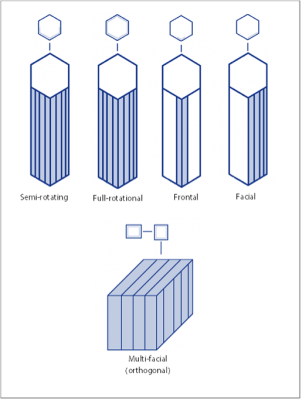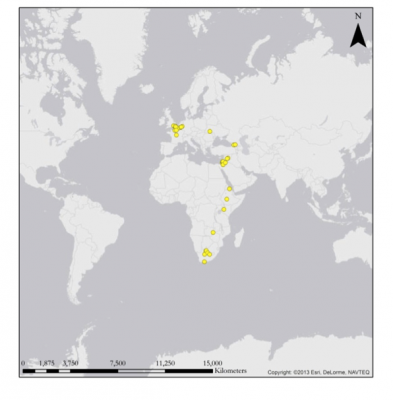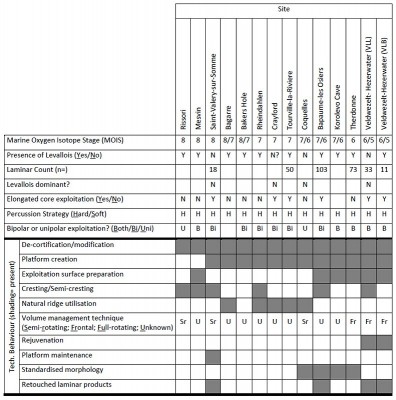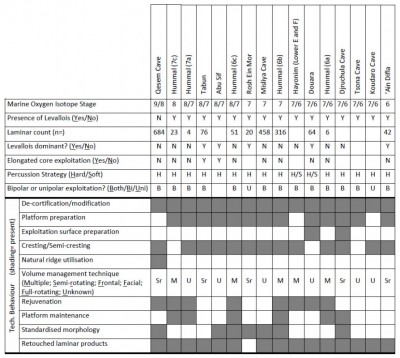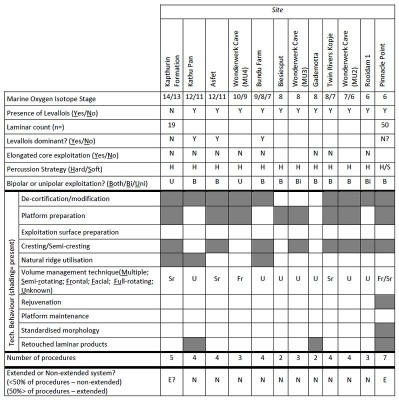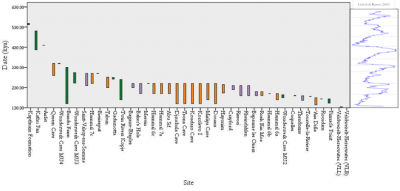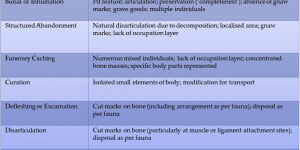Introduction
Since the earliest classifications and sub-divisions of the Palaeolithic (Lubbock 1865; de Mortillet 1867; Brueil 1912), prismatic (volumetric laminar) blade technology has been seen as a recent and sophisticated technological strategy. Originally seen as a hallmark of “modern behaviour” (see Mellars 1989; Mithen 1996), laminar technology has now been refuted as a technological strategy solely used by anatomically and behaviourally modern Homo sapiens (Bar-Yosef & Kuhn 1999; Henshilwood & Marean 2003). It is now evidenced throughout Neanderthal populations in Western Asia, and Europe, and their contemporaries in Africa. The most extensive and descriptive review of laminar technology, throughout early prehistory, is Bar-Yosef & Kuhn’s (1999) publication The Big Deal about Blades. In this publication, laminar technology before the Upper Palaeolithic was outlined, alongside Levalloisian blades, and compared to selected sites from early Upper Palaeolithic contexts e.g. Chatelperronian and Bohunician sites (Bar-Yosef & Kuhn 1999). However, given new data and refined radiometric dates for these contexts, and more extensive investigations in the earliest manifestations of blade technology, a new review of blade technology is essential. Furthermore, the origins and significance of laminar technology is poorly understood and has not been theorised before.
This article provides a review of the author’s Masters dissertation on this subject. It will review the evidence for laminar technology, prior Marine Oxygen Isotope Stage (MOIS) 5, c. 120,000 BP. Evidence after this period has been investigated before by the author (Hoggard 2012) and, given extensive reviews into techno-complexes during MOIS 5 (Delagnes 2000; Delagnes & Meignen 2005; Locht et al. 2010), it is much more pertinent to discuss the earliest occurrences. It will initially outline the fundamentals of laminar technology, how it is a different technological strategy to Levalloisian blade technology, before highlighting the evidence in Europe, Western Asia and Africa, and hypothesising the origins of this technique through the construction of a spatio-temporal chronology. It will also outline current research undertaken by the author.
Defining laminar blade technology
Laminar blade technology refers to the series of stereotyped blade removals, down the lateral edge of the core. Often labelled as “prismatic” or “volumetric” technology, the reduction strategy, as the name suggests, utilises some or the whole volume of the core, and is a proceduralised strategy involving many stages. For blade débitage, the convexity, or the longitudinal curvatures of the blade core need to be maintained for successful laminar removals; this is achieved through platform débitage (Inizan et al. 1999: 75). Vertical ridges/crests on the transverse edge of the core are also prepared, by a series of alternating/bifacial knapping strikes, for the initial blade removal (crested blade/lame à crête). Once struck, the removal leaves two arrises which continues the sequence of débitage removal. This technology can be divided into five broad categories of volume management, with one or more systems present within an assemblage (see Figure 1). Distinguishing between Levalloisian and laminar blades has been problematic for decades. There are, however, many proxies for distinguishing between these systems. These include:
- The observation of a crested/semi-crested blade (lame à crête);
- The degree of standardisation between end-products (laminar products are often more standardised than Levalloisian products);
- Laminar products are often narrower and longer with a lack of convergence on the parallel edges (with the exception of retouched laminar productions into elongated points);
- A trapezoidal or triangular cross-section is more apparent in laminar systems of blade production;
- The butt of a laminar product is often narrower than its maximum width;
- The appearance of a “chapeau de gendarme”, or éclats débordants, characteristic of some Levallois products, may be apparent.
For more extensive discussions on the process of laminar technology see (Anderson 1970; Boëda 1988; Cahen 1984; Crabtree 1968; Meignen 1995, 2000; Rasif & Andrefsky Jr. 2001; Tixier 1963, 1972, 1984).
The archaeological evidence for laminar technology
In total, there are forty-two different contexts featuring laminar technology before c. 120,000 BP (see Figure 2). Many of the typical features of laminar reduction strategies are not apparent in all instances. In some cases, the natural ridges are utilised and the degree of platform preparation is minimal. Nevertheless, all examples utilise the volume of the core similarly to Upper Palaeolithic systems of laminar technology.
In Europe there are fourteen individual contexts to feature laminar technology, with only one known context outside north-west Europe. These range from c. 300,000 BP, are not restricted to interglacial or glacial conditions, and are constantly seen throughout until the beginning of the “North-west Technocomplex” (see Delagnes 2000). The number of laminar products range from 11 to 103, very rarely feature retouch, and represent a small percentage of the overall assemblage.
The production of laminar material is not dictated by raw material morphology and type, with a variety of raw materials utilised. In almost all examples (with the exception of Saint-Valery-sur-Somme), Levalloisian technology is present and is the dominant component of the assemblage. Throughout the Middle Pleistocene there is an increase in the number of behaviours associated with laminar technology. Later examples appear more standardised, feature more retouch, and greater standardisation of the platform, suggesting increased proceduralisation. See Table 1 for an overview of European evidence.
(for references see-appendix).
In Western Asia there are at least twenty contexts to feature laminar technology. There are many others, such as Nadaouyieh Ain Askar, Aarida Sud A and Ain Juwal; however, these are poorly contextualised or dated. Chronologically, these date from 350,000 BP up until 150,000 BP, and are considerably different to the European evidence. Behaviours including standardisation, cresting, rejuvenation and retouch are present throughout, and are unparalleled in nature throughout the Middle Pleistocene. They also occur in bulk (n = <684) and are present in a variety of environments and altitudes, in a variety of laminar and Levallois dominant sites. In all but one example, they co-exist with the Levalloisian system of reduction. See Table 2 for an overview of laminar products in Western Asia.
In Africa, there are fifteen known examples of laminar technology occurring as early as 545,000 BP (some 200,000 years before its earliest appearances in the Middle East and Europe, and the proliferation of the Levallois technique c. 300,000 BP). It can be seen throughout the Middle Pleistocene, and throughout all three regions of Africa (North, Central and South). Again, Levalloisian technology is associated with all but one of the archaeological sites and, like other regions, the use of varying local non-elongated raw material demonstrates how raw material does not dictate the use of laminar production. Furthermore, similarly to other regions, laminar technology occurs in a variety of environments and interglacial/glacial conditions. Many of the behaviours associated with laminar technology such as platform maintenance, rejuvenation, and exploitation of surface preparation are absent, similarly to Europe. See Table 3 for an overview of sites featuring laminar technology.
The origins of the laminar technique: the construction of laminar technology
To understand the origins of this technique, two fundamental ideas need to be explained - 1) why does this technological strategy occur? and 2) how does this strategy become widespread? To truly understand this technique, a spatio-temporal chronology can allow a better insight into the distribution of sites over space and time. By plotting such sites over time and by region, interesting points are raised (see Figure 3). It is evident that the earliest occurrences are situated within Africa, almost 75,000 years before the use of laminar technology elsewhere. This absence of laminar technology may be substantially larger given a preference for a later date at Kathu Pan (Wilkins & Chazan 2012) and poor confidence in the dating of Asfet (see Beyin 2013). Following 350,000 BP onwards, there is a significance increase in the number of sites, right throughout until the end of the Middle Pleistocene. By cross-referencing the data with palaeoclimatological data (benthic 18-Oxygen records in Lisiecki & Raymo 2005), it is further emphasised how laminar technology is produced in a variety of climates. Further dating in the Levantine Mousterian, at such sites as Abu Sif, Hummal and the Djruchula-Koudaro complex, and African sites such as Bundu Farm will further refine this chronology.
The earliest occurrences of laminar technology in Central and South Africa satisfy many archaeologists’ view of an origin, a single point in space and time where laminar technology was produced. However, given the absence of data between c.450-350,000 BP there is a distinct lack of continuity in the archaeological record. Furthermore, given that the earliest occurrences total seventy-five laminar products (Hoggard 2013), and the increase in the number of laminar products after 350,000 BP (sites featuring up to six-hundred-and-eighty-four), it is the author’s view that (at least) two different origins can be theorised.
The first occurrences of laminar technology, before 350,000 BP, can be seen as innovations, centred around Central and South Africa, whether as an act of ‘Competence Transfer’ (Slimak, 2008), the realisation that tasks undertaken by flake technology can be completed to similar efficiency with laminar technology, or as an extension from parallel flaking systems of core reduction. Its absence elsewhere, may be accounted for by a lack of “extended” networks (Gamble 1999) within Lower Palaeolithic societies. The transfer of information, in this case a reduction scheme, may not be wide-ranging given the weak nature of “extended” networks and the nature of social structures in the Lower Palaeolithic, i.e. small group numbers and local hominid networks. Their occurrence after 350,000 BP coincides with the widespread use of Levalloisian technological strategies (Boeda 1994; Geneste 1988; White & Pettitt 1995); this cannot be ignored given their coexistence with laminar strategies in 86% of all examples. This may accompany the wider social, cognitive and behavioural changes in Europe (see White and Ashton 2003 for the ‘Neanderthalisation’ of Europe) and Western Asia, accompanied by the deeply rooted modern behavioural package in Africa (McBrearty & Brooks 2000; White et al. 2011).
In their adoption, systems of “expedient” and “curated” technologies (Binford 1973; Binford 1979; Nelson 1991) can be theorised with sites in Europe and Africa representing expedient tools: unretouched and unstandardised artefacts, low in quantity, featuring few laminar behaviours and are from local, varying raw material. Laminar products in Western Asia represent a more curated system where artefacts featured a higher percentage of retouch and standardisation, a greater number of laminar behaviours, are substantial in number, and made from more selective homogeneous material sourced further from the contexts.
One final question remains in their origin and significance: why this strategy? Many examples are produced on a variety of raw materials (both heterogeneous and homogeneous), irrespective of size and type, and feature little decortification with natural ridges and longitudinal convexities exploited. These challenge and contrast many of the assumptions of laminar technology such as the criteria for raw material needed (Bar-Yosef & Kuhn 1999; Eren et al. 2008; Hayden et al. 1996). It is the author’s view that laminar technology is advantageous in the standardisation of constant thickness, blank shape and cutting edge morphology in comparison to other Middle Pleistocene technologies. This is being further explored throughout the author’s doctoral research.
Conclusion
Since the review of laminar production by Bar-Yosef & Kuhn (1999), there has been a substantial amount of data that has been published which can credibly contextualise laminar (volumetric) technology within the Middle Pleistocene. The days of laminar products being solely Upper Palaeolithic are over, and this article has highlighted the truly enormous amount of information on laminar technology now available. With such, the origins and significance of laminar technology can be theorised and this article provides an overview into its manifestations. Many questions are left unanswered, such as: 1) why do Levalloisian and laminar technologies occur concurrently on most sites? 2) do Levalloisian and laminar strategies represent different on-site behaviours? 3) why do laminar technological strategies become not as widespread as Levalloisian technology, given its proliferation in the Upper Palaeolithic? The PhD research by the author aims to provide answers for these questions and contextualise further the role of laminar production in the Middle Pleistocene through an analysis of the European data in much more detail.
Acknowledgements
The author would like to thank the AHRC for funding this research through the BGP Research preparation award and further research through a doctoral studentship.
Appendix
References for the European data are as follows:
- Adam & Tuffreau 1973; Adam 1992, 2002; Böeda 1982; Bosinski 1966, 1986; Bringmans 2006; Bringmans et al. 2003, 2004; Cook 1986; Currant & Jacobi 2010; Currant 1986; de Heinzelin & Haesaerts (1983); Guildbaud & Carpentier 1995; Ikinger 2002; Koehler 2011; Lefèbvre 1969; Lefèbvre-Bara 1989; Liubin 1977, 1989; Locht 2000; Locht et al. 2010; Révillion 1994, 1995; Roe 1981; Ryssaert 2006; Schirmer & Feldmann 1992; Schirmer 2002; Schmitz & Thissen 1998; Scott 2011; Scott et al. 2010; Sitlivy 1996; Smith 1911; Spurrell 1880; Thieme 1983; Tuffreau 1971, 1976, 1987; Wenban-Smith 1990, 1992, 1996.
References for evidence pertaining to Western Asia are as follows:
- Akazawa 1979 ;Barkai et al. 2003, 2005, 2009; Bergman & Ohnuma 1983; Bar-Yosef & Nir 1976; Bar-Oz et al. 2005; Bar-Yosef et al. 2006; Bar-Yosef & Meignen 2001; Böeda & Muhesen 1993; Buffler et al. 2010; Clark et al. 1997; Coinman 1998, 2000; Copeland 1981, 1983; Crew 1976; Deino & McBrearty 2002; Garrod & Bate 1937; Ghebretensae 2002; Henry 2003; Jelinek 1975, 1977, 1981, 1982; Kuhn & Shimelnitz 2013; Lemorini et al. 2006; Lindly & Clark 1987, 2000; Liubin 1977, 1989; Marks & Monigal 1995; Meignen & Tushabramishvili 2006; Meignen 1994, 1998; 2007; Mercier & Valladas 2003; Mercier et al. 1995; Mercier et al. 2007; Monigal 2001, 2002; Morgan and Renne 2008; Mustafa & Clark 2007; Neuville 1951; Nishiaki 1987; Ronen 1982; Shimelmitz 2009; Shimelmitz et al. 2011; Tushabramishvili et al. 2007; Weinstein-Evron et al. 2003a, 2003b; Wotjczack 2005, 2011; Yeshurun et al. 2007.
References for the Africa data are as follows:
- Barham 2000, 2002; Beaumont & Morris 1990, 2004; Beaumont & Vogel 2006; Beyin 2013; Beyin & Shea 2007; Chazan & Wilkins 2012; Chazan et al. 2008; Clark & Brown 2001; Cornelissen 1992; Johnson & McBrearty 2010; Kiberd 2006 ; Leakey et al. 1969; Marean et al. 2007, 2010; McBrearty et al. 1996; Porat et al. 2010; Schild & Wendorf 2005; Texier 1996; Thompson et al. 2010; Wilkins et al. 2012.
Bibliography
- Anderson, D.D. (1970). Microblade Traditions in Northwestern Alaska. Arctic Anthropology VII (2): 2-16.
- Bar-Yosef, O. & Kuhn, S.L. (1999). “The Big Deal about Blades: Laminar Technologies and Human Evolution”, American Anthropologist 101 (2): 322-338.
- Beyin, A. (2013). "A surface Middle Stone Age assemblage from the Red Sea coast of Eritrea: Implications for Upper Pleistocene human dispersals out of Africa", Quaternary International 300: 195-212.
- Binford, L.R. (1973). “Interassemblage variability: the Mousterian and the “functional argument”” in Renfrew, C. (ed.) The Explanation of Cultural Change: Models in Prehistory. Duckworth, London. pp. 227–254.
- Binford, L.R. (1979). “Organization and formation processes: looking at curated technologies” Journal of Anthropological Research 35, 255–273.
- Boëda, E. (1988). “Le concept laminaire: Rupture et filiation avec le concept Levallois“ in Kozlowski, J.K. (ed.) L’homme de Néandertal: Actes du Colloque International de Liège, vol. 8, La mutation. Liège: Université de Liège. pp. 41-59.
- Boëda, E. (1994). Le Concept Levallois: Variabilité des Méthodes. Paris: Centre de la Recherche Scientifique (CNRS).
- Breuil, H. (1912) "Les Subdivisions du Paleolithique Supetieur et Leur Signification", XIV Congres International d'Anthropologie et d'Archeologie Prehistoriques, volume I. pp. 165-238.
- Cahen, D. (1984). "Technologie du débitage laminaire" in Otte, M. (ed.) Les fouilles de la place St-Lambert à Liège 1. Liège: Université de Liège. 171-197.
- Crabtree, D.E. (1968). Mesoamerican Polyhedral Cores and Prismatic Blades. American Antiquity 33 (4): 446-478.
- Delagnes, A. (2000). “Blade production during the Middle Paleolithic in Northwestern Europe”, Acta Anthropologica Sinica 19:169–176.
- Delagnes, A. & Meignen, L. (2005). “Diversity of Lithic Production systems During the Middle Paleolithic in France: Are there any Chronological Trends?” in Hovers, E. & Kuhn, S.L. (ed.) Transitions Before the Transition: Evolution and Stability in the Middle Palaeolithic. Springer Publishing. pp. 85-107.
- Eren, M.I., Greenspan, A. & Sampson, C.G. (2008). “Are Upper Paleolithic blade cores more productive than Middle Paleolithic dicoidal cores? A replication experiment”, Journal of Human Evolution 55: 952-961.
- Gamble, C. (1999). The Palaeolithic societies of Europe. Cambridge University Press.
- Geneste, J.M. (1988). “Systèmes d’ approvisionnement en matés premières au Paléolithique moyen et au Paléolithique supérieur en Aquitaine” in Otte, M. (ed.) L’Homme de Neandertal. 8. Lamutation. Etudes et recherches archéologiques de 1’Universitt de Liège 35, Liège. pp. 61-70.
- Hayden, B., Franco, N. & Spafford, J. (1996). “Evaluating Lithic Strategies and Design Criteria” in Odell, G.H. (ed.) Stone Tools: Theoretical Insights into Human Prehistory. New York: Plenum Press. pp. 9-45.
- Henshilwood, C.S. & Marean, C.W. (2003). “The Origin of Modern Human Behaviour”, Current Anthropology 44 (5): 627-652.
- Hoggard, C. (2012). “To what extent can social and ecological factors account for the appearance and disappearance of laminar technology throughout north-west Europe during the Early Glacial period (118,000-75,000 BP)?” Unpublished BA Dissertation. University of Southampton.
- Hoggard, C. (2013). “How can we account for the origins and significance of laminar technological strategies during the Middle Pleistocene?” Unpublished MA Dissertation. University of Southampton.
- Inizan, M.-L., Reduron-Ballinger, M., Roche, G. & Tixier, J. (1999). Préhistoire de la Pierre Taillée. Vol. 4. Technologie de la Pierre Taille. Meudon: CREP
- Lisiecki, L.E. & Raymo, M.E. (2005) “A Plio-Pleistocene stack of 57 globally distributed benthic d180 records”, Paleoceanography, 20
- Locht J.-L., Guerlin O., Antoine P. & Debenham N. (2000) Therdonne, le mont de Bourguillemont, AFAN/SRA Picardie.
- Lubbock, J, (1865). Pre-historic Times, As Illustrated by Ancient Remains, and the Manners and Customs of Modern Savages. London and Edinburgh: Williams and Norgate
- McBrearty, S. & Brooks, A.S. (2000). "The revolution that wasn't: a new interpretation of the origin of modern human behavior", Journal of Human Evolution 39: 453-463.
- Meignen, L. (1995). “Levallois lithic production systems in the Middle Paleolithic of the Near East: the case of the unidirectional method” in Dibble, H. and Bar-Yosef, O. (eds.), The Definition and Interpretation of Levallois Tech¬nology. Prehistory Press, Madison, pp. 361–380.
- Meignen, L. (2000). “Early Middle Palaeolithic blade technol¬ogy in southwestern Asia”, Acta Anthropologica Sinica 19, 158-168.
- Mellars, P.A. (1989). “Major issues in the origin of modern humans”, Current Anthropology 30: 349-385.
- Mithen, S. (1996). The Prehistory of the Mind: A Search for the Origins of Art, Religion, and Science. London: Thames & Hudson.
- de Mortillet, G. (1867). Promenades prehistoriques a l'Exposition Universelle. Paris: C. Reinwald
- Nelson, M. (1991). “The study of Technological Organization”, Archaeological Method and Theory 3: 57-100.
- Rasic, J. & Andrefsky Jr, W. (2001). "Blade Cores and Technological Organization in Northwestern North America" in Andrefsky Jr, W. (ed.) Lithic Debitage Analysis: Context Form Meaning. University of Utah Press, Salt Lake City. pp. 233-258.
- Slimak, L. (2008). ‘The Neronian and the historical structure of cultural shifts from Middle to Upper * * Palaeolithic in Mediterranean France’, Journal of Archaeological Science 35 (8): 2204-2214.
- Tixier, J. (1963). Typologie de l’Epipaléolithique de Maghreb, Paris, A.M.G. (Mémoire du C.R.A.P.E., Alger ; 2).
- Tixier, J. (1972). "Obtetion de lames par débitage « sous le pied", Bulletin de la Société préhistorique française 69 (5) : 134-139.
- Tixier, J., Inizan, M. & Roche, H. (1984). Préhistoire de la pierre tailleé (2) - Economie du débitage laminaire. Centre de recherches et d'études préhistoriques, Paris.
- White, M. & Pettit, P. (1995). “Technology of early Palaeolithic western Europe: innovation, variability and a unified framework”, Lithics 16: 27-40.
- White, M. Ashton, N. & Scott, R. (2011). “The emergence, diversity and significance of Mode 3 (prepared core) technologies” in Ashton, N., Lewis, S. & Stringer, C. (eds.) The Ancient Human Occupation of Britain. London: Elsevier Science. pp. 53-65.
- Wilkins, J., Schoville, B.J., Brown, K.S. & Chazan, M. (2012). “Evidence for Early Hafted Hunting Technology”, Science 338: 942-946.


